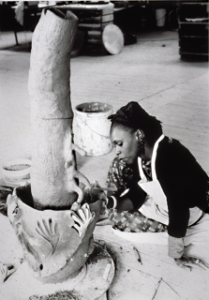
Sana Constructs Maple Tree
The many series of large and small scale sculptures and installations speak of Musasma’s life experiences over a period of thirty plus years of life experiences, working, and traveling. Works included are: The Maple Tree series, The House series, The Unspeakable series and the UnKnown/UnNamed series. Her work is meant to slow us down, look closely at the world and inspire a moment of inner silence.
Unspeakable Series
Intimate sculptures, challenging and poignant, poise an inquiry into the nature of violence and healing in women’s lives. Sana shares this story: “Twenty-five years ago, while living in Mendeland, Sierra Leone, there was a group of young girls, ages ten to fifteen, who would visit my hut every day. We began our rituals of sisterhood: they combed my hair, tried on my clothing, and applied my makeup. They taught me the formal greetings in Mende, how to sit like a Mende woman, eat with my tongue, and to never allow food to touch my lips. They showed me how to cook on three rocks and wash my clothes in the river. They taught me the birth chants, and I learned too soon, to recognized the death song. Suddenly, one morning, there were no young girls in the village. They returned thirteen weeks later, changed. Our ritual of sisterhood was no more. They no longer had the sparkle of wonderment in their eyes; they weren’t carefree young girls any longer. They didn’t want to have anything to do with me. I could not understand. I know now that they had been circumcised(incised).”
UnKnown/UnNamed Series
Works born out of the devastation of the 9/11 attacks about the hundreds of workers and others whose identity were buried under the rubble; the faceless whispers out of concentration camps; the endless mass graves throughout the world – their silent voices that remain unknown and unnamed. Inspiration coming from her travels to Cambodia, Rwanda and Vietnam , and into the homes and hearts of people she’s encountered, she’s experienced the earth that carries the memories built on the backs of oppressed/unrepresented people and their buried bones throughout the world. At My Lai, Vietnam, she walked the site and touched the soil of the massacre where the lives of hundreds of women and babies were taken in revenge. At the Holocaust museum, she inspected and pondered the owners of hundreds of eyeglasses, shoes, gold-capped teeth and briefcases. In Rwanda, a young woman described to Sana, her search for her family at a mass burial site. During her many visits to Cambodia, working with former sex slaves, she wonders about those who enslaved them.
Maple Tree Series
Multiple large-scale sculptures were inspired by the Maple Tree abolitionist movement n the late 18th century in New York and Holland. Dutch colonists, Native Americans and free indentured African servants joined together in protest against slave labor on sugar cane plantations in the West Indies. They took as their symbol the maple tree – a source of sugar without exploiting slave labor. Musasama’s tree sculptures, abstracted with elements of the human body, explore connections between trees, sexuality and human agency.
The House Series
Human scale terra cotta sculptures that speak about kinship, culture, life and living. This body of work concentrates on the environment and personal circumstances. The image of the house, a universal symbol that is communicative, cross-cultural and panoramic, evolved into small-scale temples some featuring imagery from travel, while others are drawn from multiple sources of inspiration.
